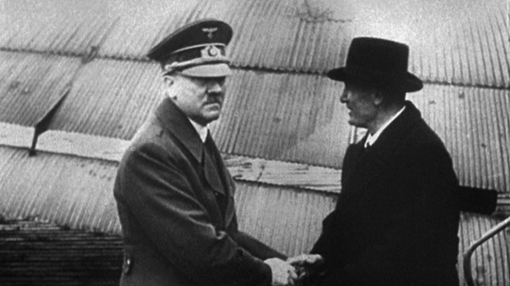The World at War – 40 years later
Isaacs and his production team – including associate producer Jerome Kuehl, film researcher Raye Farr and Susan McConachy who co-ordinated the many interviews with participants – worked for two years on The World at War. In total it comprised 26 episodes running to almost 21 hours of television. There were two guiding principles in making the series. The first was that the interviewees would be ‘ordinary’ people rather than generals or statesmen: Isaacs wanted The World at War to describe the experiences of participants from the bottom up rather than the top down. This differentiated it from previous television histories of the Second World War such as ABC’s Crusade in Europe (1949) and the BBC’s The Valiant Years (1961) which had been closely tied to the accounts of major figures (Eisenhower and Churchill respectively). The second principle was that the series would make use only of genuine actuality film and should avoid reconstructed footage. In an internal memo of October 1972, Isaacs impressed upon the production team that ‘it is important to remember that we are not making “poetic” films with licence to use footage where we please. We are making an historic series and should not knowingly use pictures purporting to be what they are not.’ (6) When using reconstructed material was unavoidable, it was identified as such either in the commentary or through an on-screen caption.
… it was estimated that some three and a half million feet of archive film were viewed
The publicity surrounding The World at War went to great lengths to emphasise the amount of research – it was estimated that some three and a half million feet of archive film were viewed in the preparation of the series. This included some material from the commercial newsreel libraries such as Movietone and Pathé, though the bulk came from the Imperial War Museum and other national archives. However, the researchers were denied access to Soviet and East German archives, which meant that the episodes dealing with the Eastern Front had to make do with captured Soviet film discovered in the Federal Bundersarchiv in Koblenz.
Reception
The World at War was warmly received by television reviewers who particularly admired its use of previously ‘unseen’ footage and the eye-witness testimony of ordinary people: to this extent it very much became the model for future historical documentary series such as The People’s Century and The Nazis: A Warning from History. Most critics were impressed by the fair-mindedness of the series and by its uncompromising representation of the horror and brutality of war. The World at War had none of the triumphalism of Cold War-era series such as NBC’s Victory at Sea (1952) – both Carl Davis’ music and the commentary by Laurence Olivier (Isaacs’ one concession to ‘star’ names, chosen with a view to US sales) were suitably somber in tone. There were some criticisms, however. The Morning Star – official mouthpiece of the Communist Party of Great Britain – felt that early episodes neglected the role of the Soviet Union; it later conceded, following ‘Barbarossa’, ‘Stalingrad’ and ‘Red Star’, that this omission had been remedied. And several critics were uneasy about the episode ‘Genocide’ dealing with the death camps and the extermination of the Jews, feeling that some of the footage shown was too horrific for primetime viewing.

 Learning on Screen
Learning on Screen
